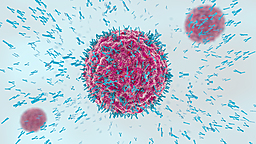Helical Epitope and Single Chain Fab Fragments to Aid Structural Studies of Membrane Proteins
TECHNOLOGY NUMBER: 2020-282

OVERVIEW
A novel method that fuses a common epitope to any selected membrane protein- Expands the ability of existing technologies to define membrane protein structure
- Provides access to smaller and less rigid proteins for structural analysis
BACKGROUND
Determining the structure of a protein is an integral step in the development of therapeutics for specific diseases. While membrane proteins may play a part in common illnesses such as heart disease, Alzheimer's dementia, and cystic fibrosis, relatively few of the known membrane proteins in human cells have a structure that has been fully elucidated. One of the obstacles to structural identification of membrane proteins is the requirement for advanced techniques to successfully prepare the samples. One strategy to increase the suitability of these proteins for structural study involves selection of antibodies that bind to them, though the process for identifying these antibodies has been proven to be slow and prohibitively expensive. As such, a need exists for improved methods to define membrane protein structure.
INNOVATION
Researchers at the University of Michigan have invented a method that creates the ability for an epitope to be fused to a selected membrane protein, permitting the same human antibody fragments to be used in structural studies of any membrane protein-epitope fusion. The innovation involves the fusion of an epitope derived from an HIV protein's membrane proximal external region (MPER) with the protein of interest. This epitope is then recognized and bound by human-derived antibody fragments, improving the yield of the existing cryogenic electronic microscopy (cryo-EM) method for defining protein structure. The researchers have also engineered smaller, single-chain antibody fragments which can be expressed in Escherichia coli and therefore recovered inexpensively. Overall, this technique allows for the capture of smaller as well as less rigid membrane proteins, which is a marked improvement when compared to existing capabilities.